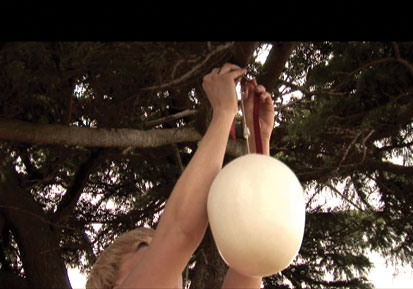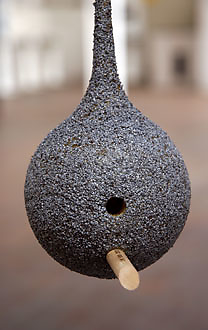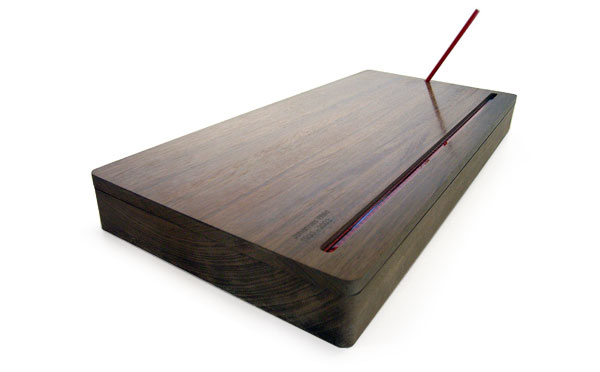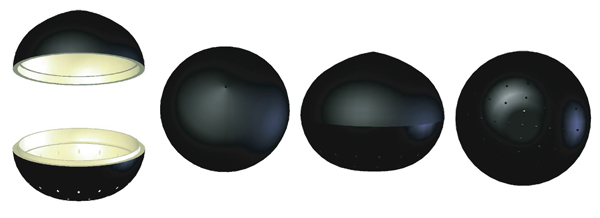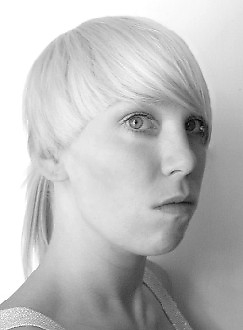She refers to her work as "an ongoing research project that looks to challenge our post mortem traditions and to offer proposals for alternate treatment for our deceased." She has designed urns that lengthen the death ceremony to give more time for the grieving to come to terms with their loss.
In her project RIP -Rest In Pieces, A ceramic urn is suspended from a tree. The cord holding the urn has a lifespan of 1-3 years. The thread gradually degrades causing the urn to drop, and smash as it hits the ground. Each Rest in Pieces ceramic urn will eventually fall to the ground – smashing the container and scattering the ashes to the wind, while leaving a permanent memorial behind.
Jarvis' bird feeders are somewhat less suspenseful than the suspended ceramic urns, but nonetheless are remarkably charged with life, activity and renewal. Just the idea that a bird feeder could make thought provoking art and death statement is surprising to me, but these unassuming and beautiful pieces pack a conceptual punch. Enlisting the aid of birds, Jarvis draws out and dramatizes the return of remains to the earth.
The Bird Feeders – made from either solid castings of bird food, beeswax and ash or rotationally moulded with the ash encased inside – encourage birds to either eat and naturally purge the ash or peck through the edible exterior and allow the ash to be released over a period of time. The ceramic urns and bird feeders redress conventional methods of commemorating the deceased, ultimately removing the responsibility of ash scattering by allowing external factors to decide when to lay someone to rest.
www.designmuseum.org/design/nadine-jarvis
As a lover of drawing and writing, by far, my favorite of the lot is Jarvis' pencil box. Incredibly, carbon from cremated remains is used in place of graphite in the pencils. Jarvis has many thoughtful details worked into this piece, but somehow what I like best about this is the fact that you get so many pencils. This will help to prevent them from being too 'precious' to use every day which would defeat the whole purpose.
From Ms. Jarvis' site, here is a tantalizing list of thoughtful features worked into the Carbon Copies pencil case design:
Pencils made from the carbon of human cremains. 240 pencils can be made from an average body of ash - a lifetime supply of pencils for those left behind.Each pencil is foil stamped with the name of the person. Only one pencil can be removed at a time, it is then sharpened back into the box causing the sharpenings to occupy the space of the used pencils. Over time the pencil box fills with sharpenings - a new ash, transforming it into an urn. The window acts as a timeline, showing you the amount of pencils left as time goes by.
Here is an excerpt from an interview with Ms. Jarvis on Designmart.com:
Q. How did the design of the Rest in Pieces and Birdfeeder projects develop?
A. I have always been fascinated with the life and death of objects... My work has always dealt my concerns about impermanence in materials, technology and people. Through my work I have investigated the relationship between person and object and the wonderful idiosyncrasies of human behavior.
The Rest in Pieces and Birdfeeder projects were a continuation of this interest and came from my research into the death of materials and concepts of nothingness. It developed as quite a ‘back-to-front’ project, I wanted materials to lead my project and so I started gathering interesting materials and experimented with them – watching them fall apart over time. I started to think about death in terms of grief, and how the degradation of materials could be used to aid that grief, and imagined how the deceased could be reincarnated through the design of memorial objects.
© Design Museum www.designmuseum.org/design/nadine-jarvis
What's next? Well, the image above is from Jarvis's project 'Scatter'. That page on her site is still under construction, so I don't have any details on it yet. However, judging by her previous work, I'm sure this container is much more than meets the eye. Thank you, Ms. Jarvis, for challenging and qualitatively changing our 'postmortem traditions'. I hope that these ideas can move beyond the gallery and become available for use. I never wanted to be cremated, but if I can be a box of pencils?........
Nadine Jarvis's "Post Mortem Research", including three Scatter vessels, two Rest in Pieces, one Carbon Copies and two Bird Feeders, were installed September 2008 at Art Honors Life® | The Gallery at FUNERIA in the hamlet of Graton, Sonoma County California. The pieces are currently on exhibit at Funeria. For more information, visit www.funeria.com/
Originally posted on Daily Undertaker. For the full article, visit www.dailyundertaker.com/2009/02/nadine-jarvis-post-mortem.html
